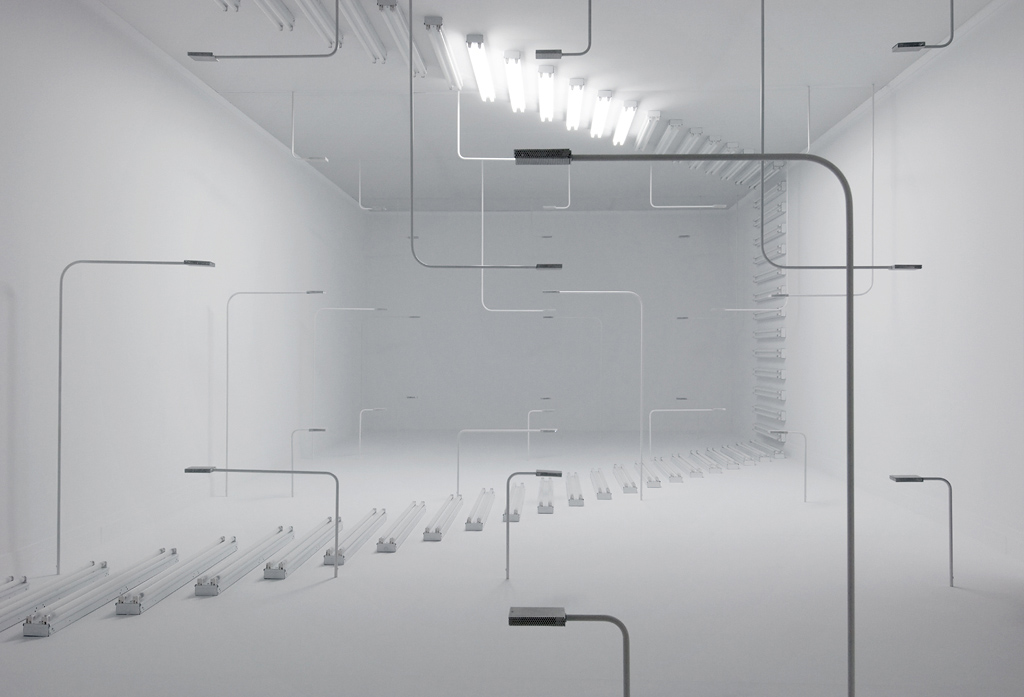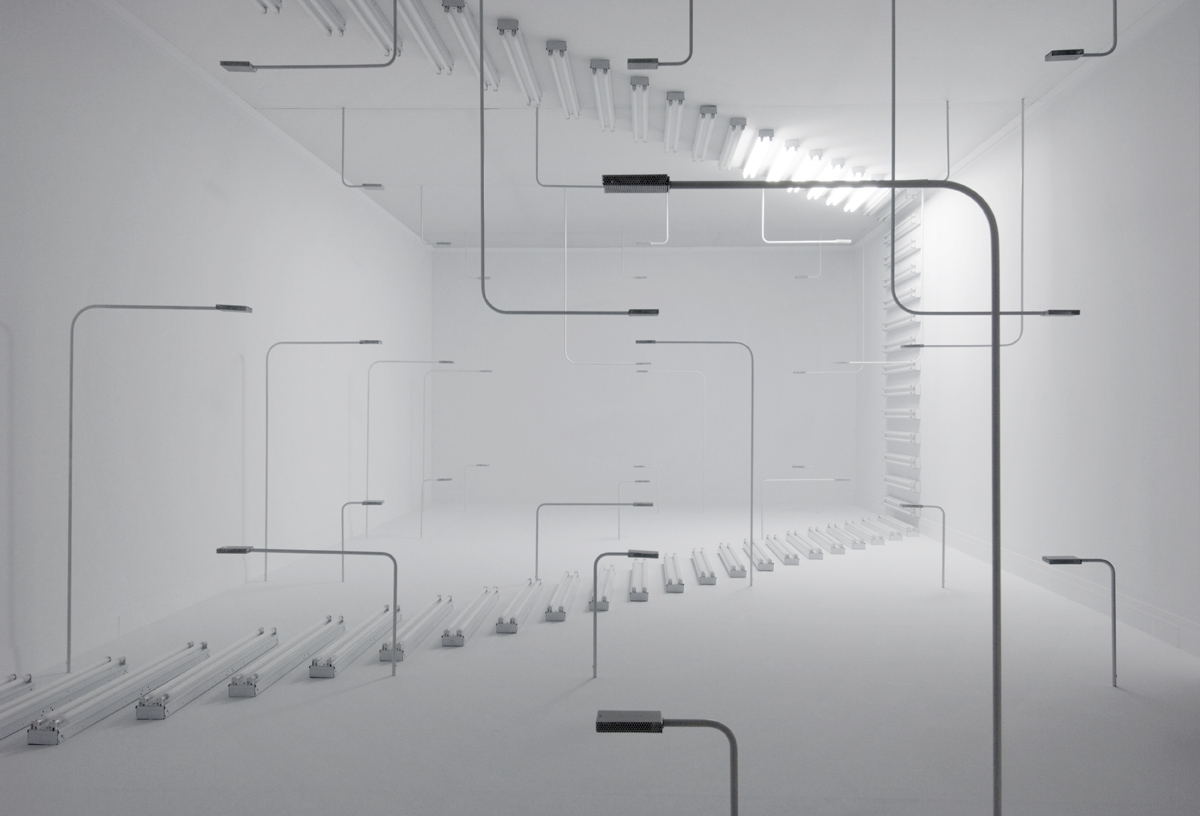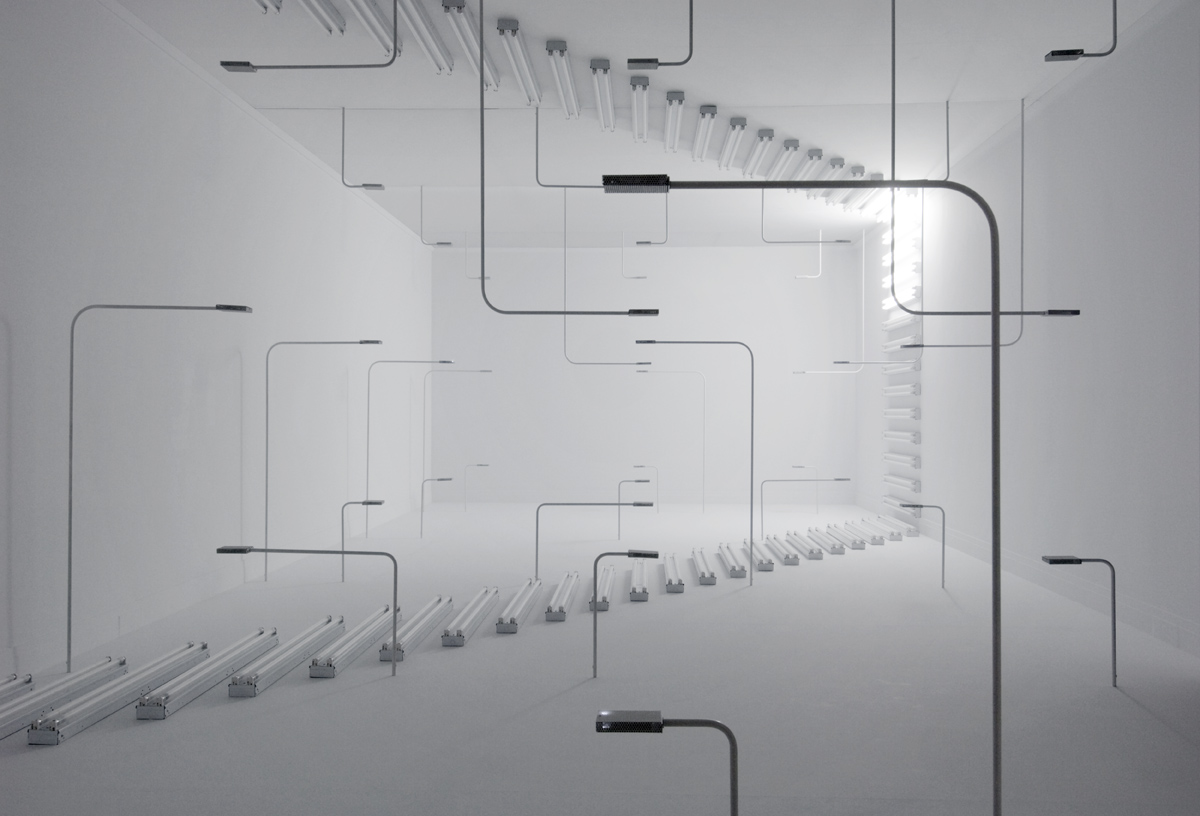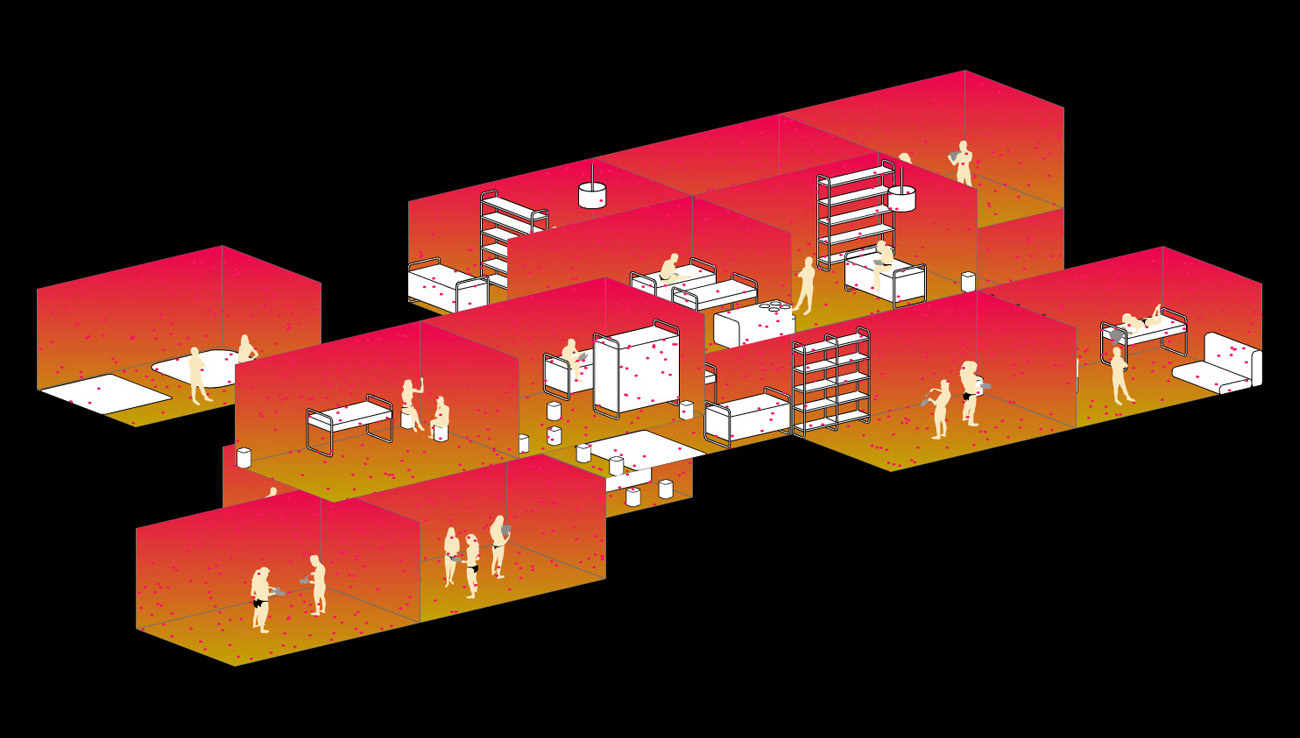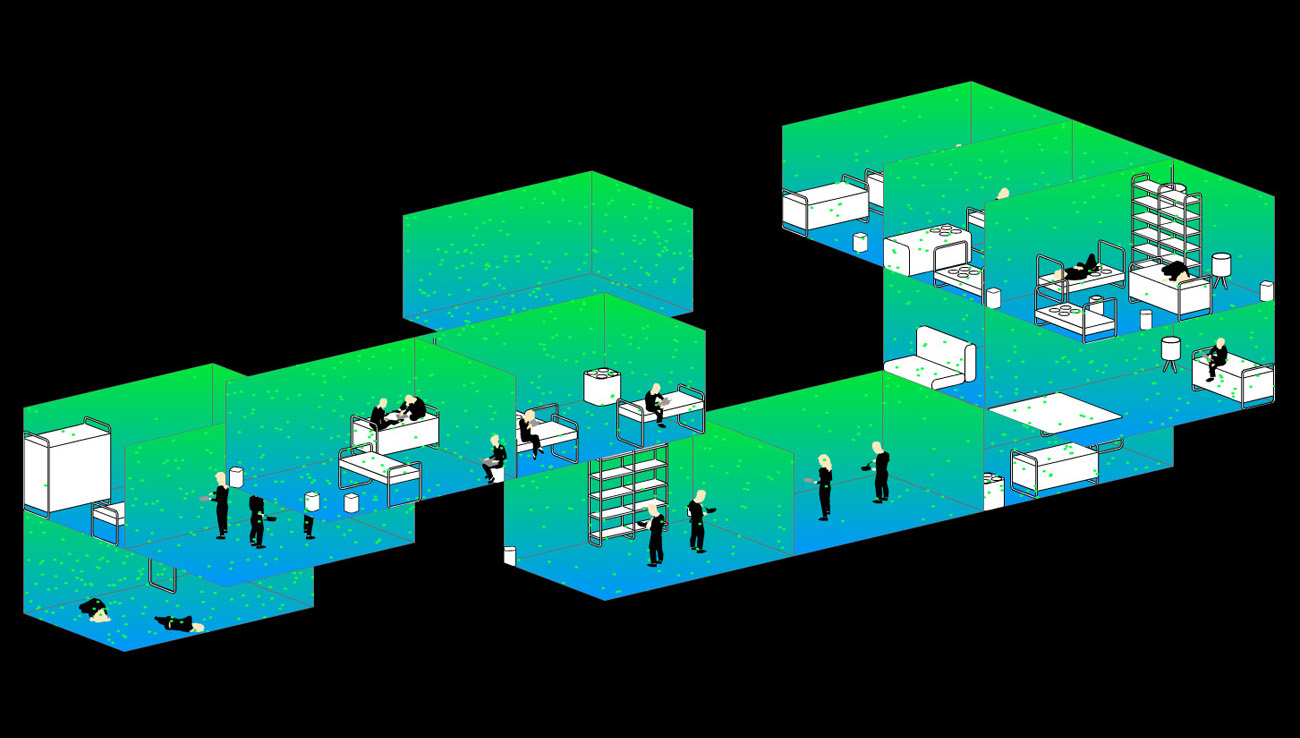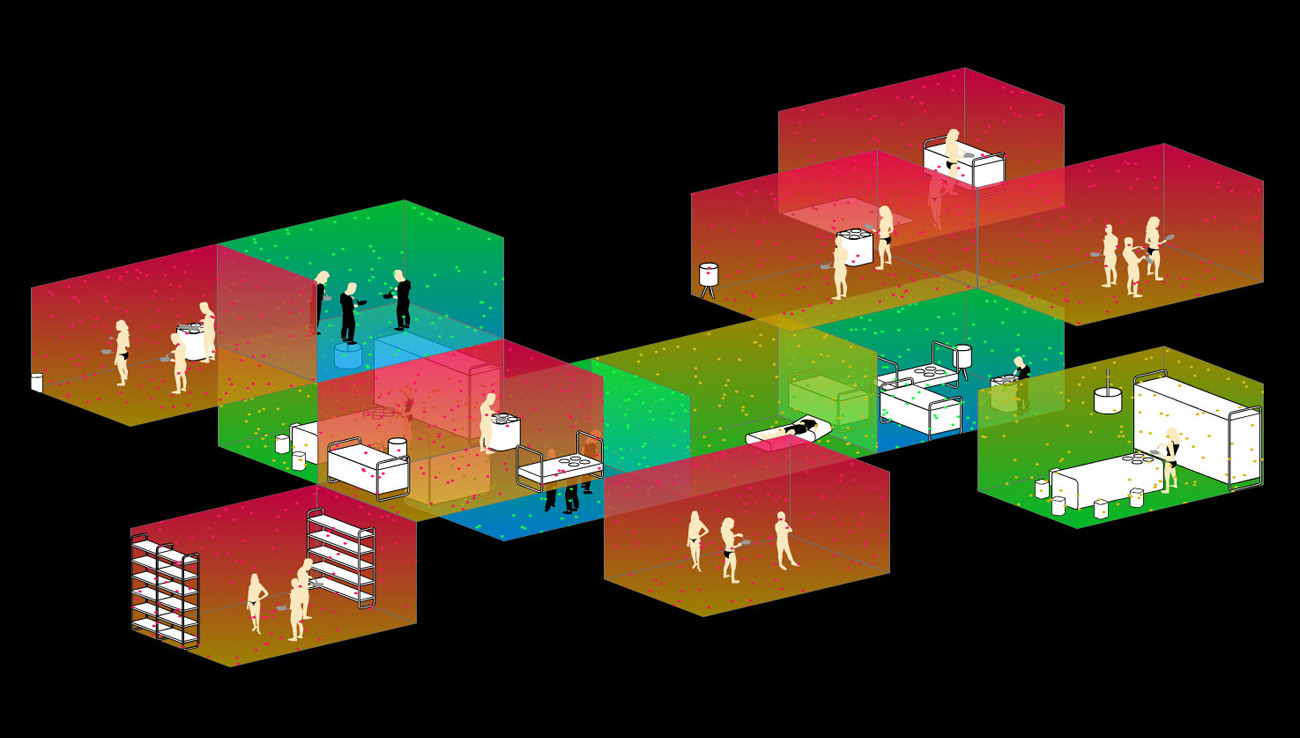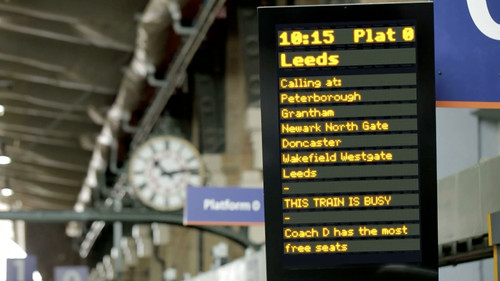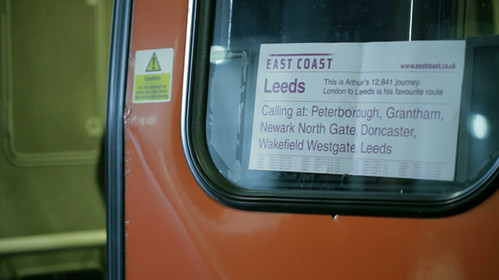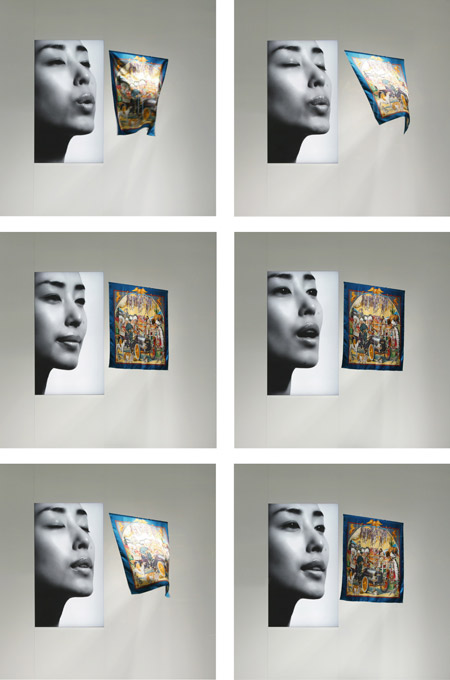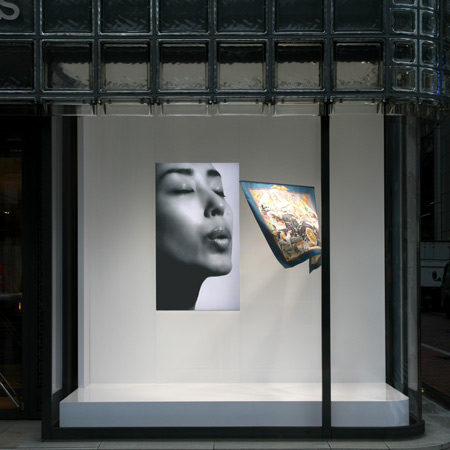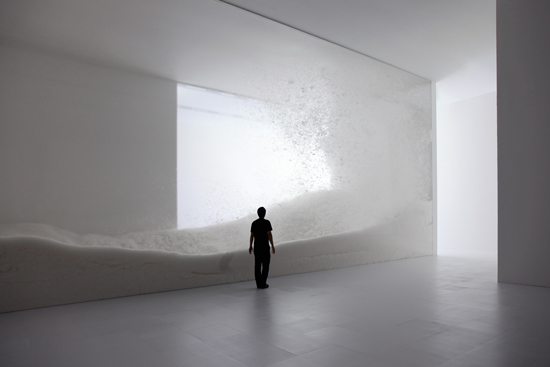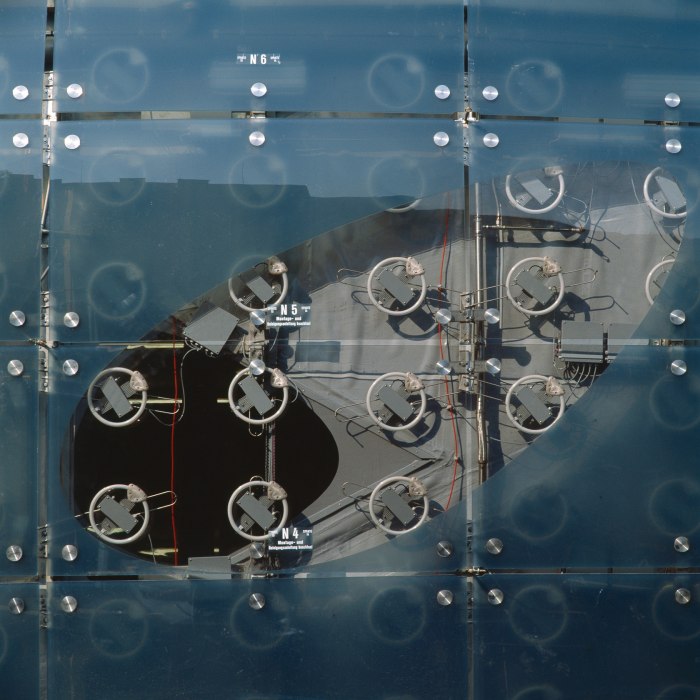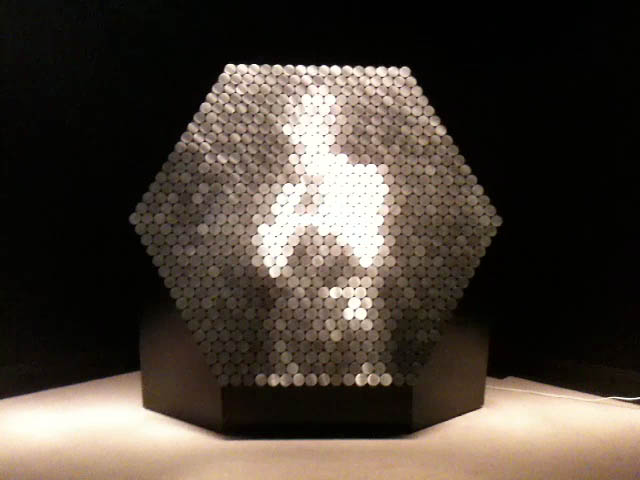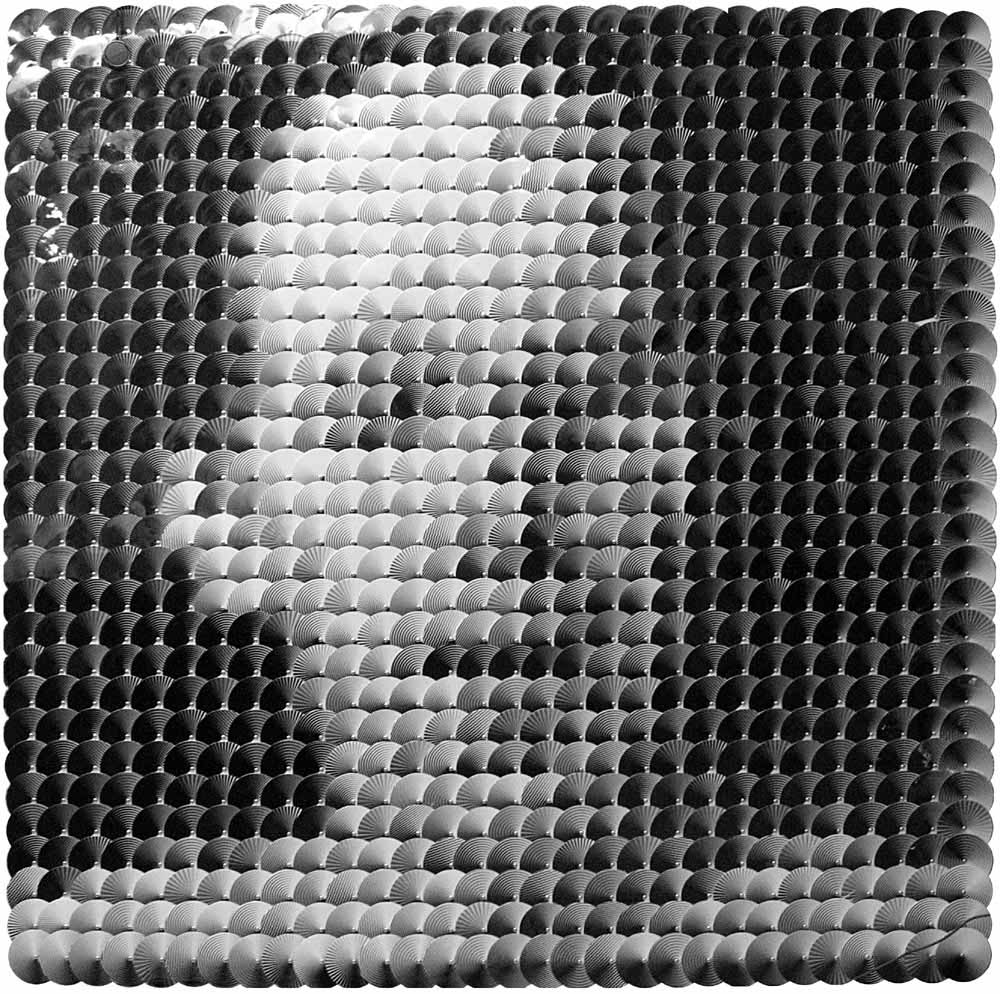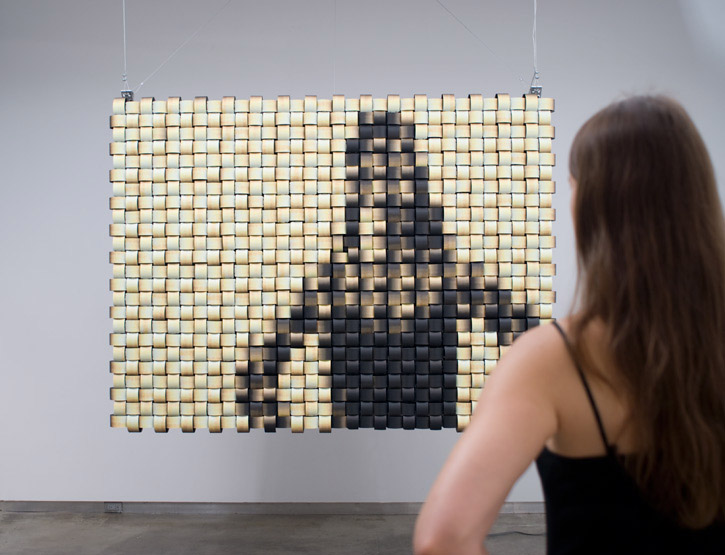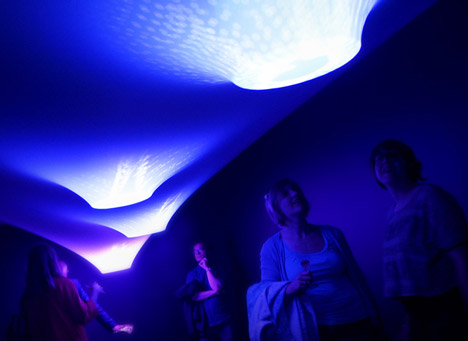HYDRAMAX Port Machines
Posted by @cbadal
Future Cities Lab’s HYDRAMAX Port Machines project proposes a radical rethinking of San Francisco’s urban waterfront post sea-level rise. The proposal renders the existing hard edges of the waterfront as new “soft systems” that would include aquatic parks, community gardens, wildlife refuges and aquaponic farms. A synthetic architecture is introduced that blurs the distinction between building, landscape, infrastructure and machine. Using thousands of sensors and motorized components, the massive urban scale robotic structure harvests rainwater and fog, while modulating air flow, solar exposure and intelligent building systems.
Interactive Model Description: A network of infrared proximity sensors has been integrated into the four sides of the physical model. These sensors record the distance of gallery visitors to its edges. Information from these sensors is used to actuate the white feather-like “fog harvesting robots” and control the brightness of embedded LEDS. This model is an example of what Future Cities Labs call “live models”. Live models use the interaction of people to explore and simulate the potential effects of environmental forces such as fog, wind and sunlight.
See video of model here
Vessels
Posted by @cbadal
Vessels is a robotic installation consisting of large groups of autonomous water vehicles. With roughly 50 individuals in a population, the robotic agents interact with each other and their environment to form a simple ecosystem. Their collective, emergent behaviour resembles the social interactions in a community of living creatures. While moving on water, each of the robots collect and interpret data from different environmental conditions such as water and air quality, temperature, ambient light, sound, etc. Since no single agent has more than one or two sensors, they depend on communicating with each other to form a complete awareness of their environment. However, the robots do not simply exchange scientific readings: instead they communicate through behaviours and interactions. For example, an increase in temperature sensed by one agent may cause it to act more aggressively, with erratic or irrational (random) movements. This change in behaviour will influence its neighbouring agents, who may respond with relative changes to their own behaviour. These agents will in turn influence their neighbours, thus creating a ripple effect of actions. Over time, a collective behaviour that is specific to the immediate environmental characteristics of the presentation site emerges from the agents’ interactions.
See video here
See bot specifications here
T(ether)
Posted by @cbadal
T(ether) is a novel spatially aware display that supports intuitive interaction with volumetric data. The display acts as a window affording users a perspective view of three- dimensional data through tracking of head position and orientation. T(ether) creates a 1:1 mapping between real and virtual coordinate space allowing immersive exploration of the joint domain. Our system creates a shared workspace in which co-located or remote users can collaborate in both the real and virtual worlds. The system allows input through capacitive touch on the display and a motion-tracked glove. When placed behind the display, the user’s hand extends into the virtual world, enabling the user to interact with objects directly.
See video here
See other Tangible Media Group at MIT Media Lab projects here
Local Warming
Posted by @cbadal
Local Warming is a prototype that aims to challenge the status quo. Through the use of sophisticated motion sensing and autonomous control, the installation provides people with direct and localized warmth. An infrared energy beam follows the user’s movement so they can be comfortably warm in an otherwise cold environment and thus the inefficiencies of ambient heating are avoided all together. For this installation, the participants are welcomed by a carpet marked with symbolic foot prints. By standing in this location, the users can engage the system, and the warmth will follow them through space. By installing the system outdoors, the paradigm shifting possibilities are amplified. It provides the ability to manipulate unenclosed environments—in an efficient manner—to a degree allowing us to utterly blur the architectural boundary between interior and exterior beyond the removal of physical obstructions.
See video here
See other Senseable City Lab projects here
Interior Weather
Posted by @cbadal
The installation at the CCA is conceived as two spaces, one gallery designated as the locus of production and measurement of an "interior weather" condition, and the other as the locus of interpretation of the resultant data. The first room could be described as objective, the second as subjective. The goal is to project an architecture that is capable of indicating possible uses of space which are dictated only by the chance confluence of three climatic parameters: temperature (celsius), light intensity (lux), and relative humidity (%), so that T * lux * HR = form and function. The installation is conceived as a study to test the potential of fluctuating climatic conditions to generate new functions, and thus new architectural programmes. The proposals offered here are in no sense univocal: they represent the realm of sheer accident and possibility, one interpretation, and obviously not the only one.
Note: You should read the rest of the description on the Philippe Rahm website to make any sense of this.
See other Philippe Rahm projects here, eg. Convective Apartments
Wireless Sensor Network
Posted by @cbadal
From the KieranTimberlake blog on one particular application: Architects rely on energy models to verify that buildings will perform to desired energy standards, but simulation alone does not provide a tacit understanding of the nuanced conditions buildings experience over time. To supplement energy models, we deploy sensor networks to monitor environmental attributes such as temperature, relative humidity, and carbon dioxide. This is particularly relevant to building retrofits, where the data informs performance modifications, targeting both energy efficiency and occupant comfort, all intended to improve existing building stock and advance our knowledge of the interaction of materials and climate.
See also coverage by Architect magazine here
"One Hundred and Eight"
Posted by @kamillacsegzi
Created by Nils Völker, One Hundred and Eight is an interactive wall-mounted Installation made out of ordinary garbage bags. Controlled by an Arduino and Processing, each of the bags is selectively inflated and deflated in turn by two cooling fans. The installation runs in either “patter mode” or reacting to people nearby. The installation consists of 108 interconnected modules made from MDF. Each single one is equipped with a white, semi transparent plastic bag, two cooling fans and a relay that switches the electric current between the fans. One program is running on an Arduino mounted to the lower side taking control of a set of shift registers that trigger the relays individually. A camera is mounted to the ceiling above and connected to a computer on which a second program (Processing) is running. The program registers and tracks movement via the camera and sends the necessary information via a serial connection to the microcontroller.
"Dune"
Posted by @kamillacsegzi
Designed by Studio Daan Roosegarden, it is a public interactive landscape that interacts with human behavior. This hybrid of nature and technology is composed of large amounts of fibers that brighten according to the sounds and motion of passing visitors. Evolving through several contexts DUNE 4.1 enhances social interactions in the public pedestrian Maastunnel, commissioned by the Rotterdam City of Architecture.
For more visit: Dune
"Playtime Interactive Dresses"
Posted by @kamillacsegzi
Designer Ying Gao is showing three series of "intelligent" garments which move and change in response to sound, motion or light in Quebec City this summer. Inspired by Jacques Tati's film Playtime (1967), the Playtime garment series illustrates the ability to metamorphose when one tries to take their picture. Playtime 1 reacts to a camera flash by contracting and becoming blurred as the fabric, activated by light-sensitive sensors, begins to undulate. For Ying gao, "this blurriness is a space of freedom which defies the supremacy of the image, that capital element of the fashion milieu." See video Vimeo. For more visit: Playtime
"Beast"
Posted by @kamillacsegzi
Beast is an organic-like entity created synthetically by the incorporation of physical parameters with digital form-generation protocols. A single continuous surface, acting both as structure and as skin, is locally modulated for both structural support and corporeal aid. Beast combines structural, environmental, and corporeal performance by adapting its thickness, pattern density, stiffness, flexibility, and translucency to load, curvature, and skin-pressured areas respectively.
"Sephora Sensorium"
Posted by @kamillacsegzi
"Sephora presents "SENSORIUM - LUCID DREAMS from the SENSORY WORLD" with magic by Firmenich. Imagine a dynamic place where smell, taste, touch, sight and sound become one complete gesture — a 4D sensorial environment dedicated to the magic of scent."
See video on Vimeo.
"WaterfallSwing"
Posted by @kamillacsegzi
The swing is a collaborative project between Mike O’Toole, Andrew Ratcliff, Ian Charnas and Andrew Witte. Water recirculates through 273 independently controlled solenoid valves at the top of the structure to create a wall of water. This water starts from a collection pool on the ground and is pumped up to a large pipe that feeds the solenoids. Sensors mounted on the swingset gather information about the angle and speed of each swing. That information is sent to a computer that predicts the action of the rider. The computer then creates a hole in the wall of water, allowing the rider to swing through without getting wet.
"Media Surfaces"
Posted by @warshawshaw
"Media Surfaces" is a pair of 'video sketches' by the design consultancy firm Berg London (the same guys who made the Little Printer) that don't put any impressive new technologies to work so much as they explore how the banal elements of consumer media in public spaces might be creatively appropriated. In "The Journey," for example, Berg imagines a train station that interacts with customers almost humanly: signs refer to each train by a name, the ticket kiosk displays a wait time, and arrival boards note which cars are most full. Capitalizing on the print elements of travel, the project includes personalized tickets that mention durations, weather, and points of interest for each journey.
Void
Posted by @warshawshaw
In a similar vein to Jürg Lehni's work, Wit Pimkanchanapong's sculpture plots in space rather than on a 2D surface. A fly system anchored at eight points swings a weight with eight alternating light strips attached to it around the space of a vacant city lot. The effect in real time is of bright flashing lights that jump around the space, although long exposure photos capture the illuminated strips at individual light drawings.
Mirror
Posted by @warshawshaw
"Mirror" is a permanent installation by Doug Aitken on the main facade of the Seattle Art Museum. Composed of two horizontal LED screen panels and multiple vertical LED strips, the piece culls snippets of video shot by the artist in and around Seattle and plays them in an always changing sequence. Sensors on the facade measure temperature and weather condition as well as traffic and pedestrian densities, rearranging the order of the montage in response.
Official site
Illumiroom
Posted by @warshawshaw
Illumiroom is an augmented reality project by Microsoft Research that uses a projector and a Kinect for Windows camera to read the visuals of a videogame being played on a normal TV and extend its contents and motion out onto surrounding walls in order to fill in peripheral information. For example, if a user were playing a car racing game, it would unite the features of the room with those portrayed on-screen by overlaying the wider angle of a tight corner or a straightaway right over any furniture or adjacent surfaces. It can also make use of the room as a 3-D environment, making the motion of objects within the gameplay sensitive to the real-life environment once they pass from screen surface to room surface.
Project website.
Aireal
If Leap Motion and the Kinect allows users free gesture control for computers, games, robots, et cetera, the Aireal adds a layer of haptic feedback to their use. It works as if it were a webcam for tactile sensation. It is equipped with a camera that tracks a user's motion, and using a nozzle manipulated by a small motor, blasts targeted rings of air at the user's body to complement his or her simultaneous control of a visual display. If one is typing in midair using the Leap, for example, an Aireal positioned below the hands could simulate the tactile experience of hitting the keys by shooting bursts of air at each finger as it makes a keystroke. Depending on its position, it can also complement visuals that are projected onto the body, simulating, for example, the feeling of a bug crawling up an arm as a projected bug actually does so.
Holistic Strata
Posted by @dinamahmoud
In addition to the characteristic elements of light and sound in his previous works, Hiroaki Umeda’s new piece Holistic Strata introduces a new system built around a key component of ‘physical data’ generated by the dancer’s body movements.
A further leap forward from Umeda’s tried and tested concept of treating light, sound and the human body as equivalent means of expression on stage, Holistic Strata revolves around the body as a complex cluster of information that configures actual spaces. Umeda’s body data (movements of muscles and locomotion coordinates) is manipulated with the help of sensing technology and results in the creation of a scenery that integrates dance, sound, and intensely blinking light. Based on this system of freely generated imagination, Holistic Strata proposes ‘dance’ as a spatial expression, while highlighting the criticality of our perception. link
Firewall
Posted by @dinamahmoud
An interactive media installation created in collaboration with Mike Allison. A stretched sheet of spandex acts as a membrane interface sensitive to depth that people can push into and create fire-like visuals and expressively play music. Firewall was made using Processing, Max/MSP, Arduino and a Kinect. The Kinect measures the average depth of the spandex from the frame it's mounted on. If the material is not being pressed against, nothing happens. When someone presses into it the visuals react around where the person presses, and the music is triggered. An algorithm created with Max allows the music to speed up and slow down and get louder and softer, based on the depth. This provides a very expressive musical playing experience, even for people who have never played music before. A switch is built into the frame which toggles between two modes. The second mode is a little more aggressive than the first. link
Maison Hermes Window Display
Posted by @dinamahmoud
Based on a window display he first presented in 2004, the japanese designer tokujin yoshioka has now restructured it using a japanese actress currently being presented at Maison Hermès, japan. the installation will run from now until january 19th, 2010. 'on designing a window-display of Maison Hermès, I intended to express people’s daily 'movements' with a suspicion of humor. there are moments when I perceive a hidden presence of a person in the movements born naturally in daily life. I created a design where one can perceive someone behind the scarves as if life were being breathed into them. the window is designed with an image of woman projected on to a monitor. the scarf softly sways in the air in response to the woman’s blow. ' - TY link
Snow
Posted by @dinamahmoud
tokujin yoshioka's project 'snow' is a dynamic 15-meter-wide installation. it consists of a scene depicting hundreds of kilograms of light feathers blowing all over and falling down slowly is meant to remind us of the snow scape of our memories and the beauty of nature which often exceeds our imagination. visitors to the exhibition experience the feeling of looking at or walking through a snowstorm. link
Filament Mind
Posted by @dinamahmoud
Filament Mind is a human information-driven installation designed to visualize the collective curiosities and questions of Teton County Library visitors through a dynamic and interactive spatial sculpture. Whenever any Wyoming public library visitor anywhere in the state performs a search of the library catalog from a computer, Filament Mind illuminates that search in a flash of color and light through glowing bundles of fiber optic cables. Each of the 1000 fiber optic cables hanging above (totaling over 5 miles of cable) corresponds to a call number in the Dewey Decimal System, which organizes the library’s collection into approximately 1000 categories of knowledge. These category titles are displayed in text on the lobby’s south and north walls at the termination points of the fiber optic cables.
Hello Stranger
Posted by @yifeng
Hello Stranger was an interactive installation consisting of a field of 30 LED pillars arranged in a field and embedded in gravel. Each pillar is 3m tall and has 12 individually addressable RGB elements. Together they form a sparse 3D display which is immersive (you can walk through it), tangible (you can touch it) and real (as opposed to virtual). It was exhibited during the 2005 Science et Cite festival in Zurich. A non-interactive version was shown at the the 2006 Les yeux de la nuit exhibition in Geneva.
The interactions: Heart - the beating red heart at the centre of the space speeds up as you approach it Rain - it always rains red on you Fire - release fireballs from the gravel as you walk Cortex - simple 3D walk-through model of activation between and across layers of cortex Flower - flowers open as you walk through the gravel Tornado - swirling lights follow you around Spectrum (not interactive) - possibly the world's biggest Hi-Fi spectrum analyser see more (http://www.ini.uzh.ch/~kynan/teaching/hellostranger/)
Communicative Display Skin for the Hunsthaus Graz
Posted by @yifeng
The idea of the media installation BIX arose out of considerations on how to equip the interior of the Kunsthaus in Graz with media (≥KMA). BIX was created as an additional feature at a time when overall planning of the Kunsthaus had already reached an advanced stage.Constructed from about 1,300 individually shaped, translucent Plexiglas panels covering the biomorphic building, the so-called skin was intended to feature different nuances of transparency, which would have created varying communicative relationships between interior and exterior. (http://www.youtube.com/watch?v=Uq1lkrtAJ_0)
Nervous Structure - Interactive Installation
Posted by @yifeng
Nervous Structure is a series of site-specific, interactive installations consisting of string and fabric structures illuminated with interactive computer graphics that react to the presence and motion of viewers. Made collaboratively by Annica Cuppetelli and Cristobal Mendoza. more on vimeo(http://vimeo.com/35508462)
In Order to Control | Interactive Installation
by @yifeng
It’s one thing to stand in font of a projector to create shadow puppets, but it’s an entirely different experience to block a text-based floor projection and see your typographic silhouette on an adjacent wall. Istanbul-based multidisciplinary creative studio NOTA BENE Visual has designed a mind-boggling audiovisual installation using an intricately executed video-mapping technique that uses the latest technology to create an artistically intriguing environment for spectators to engage in. more information (http://www.feeldesain.com/in-order-to-control-interactive-installation.html)
SFMOMA: LED Lights Transform into 3D Screen
Posted by @yifeng
Artist Jim Campbell just recently debuted "Exploded Views," a random cascade of flickering LED lights...or so you think. Make it up to the 2nd floor landing and watch the lights transform into a 3D screen where human figures magically come to life! Part sculpture, part cinematic screen, the grid is composed of thousands of computer-controlled LED spheres that create the illusion of fleeting shadow-like figures. (http://www.youtube.com/watch?feature=player_embedded&v=W4T5kECTYaE#t=188) on youtube
Lunar Trails
Posted by @jstoddart
Lunar Trails was a project by artist, Seb Lee-Delisle, for the GAME exhibition at the Dublin Science Gallery. The project used a vintage arcade game, Lunar Lander, and linked the player's actions on screen to a wall-drawing robot. The robot would inscribe each player's trajectory on the wall-mounted canvas, producing a layering of multiple attempt (and successes and failures) at landing their lunar lander. Lunar Trails on Vimeo.
Blur: braincoats
Posted by @jstoddart
The Braincoat was smart raincoat created for Diller Scofidio's Blur Building for the Swiss Expo in 2002, but was ultimately unrealized in the final project. With their sensory experience impaired by the pavilion's fog generators, the _braincoat _acted as a proximity-based social surrogate, using sensors and logic to instigate interaction. Prior to entering the pavilion, users were asked to fill out a questionnaire. Once inside the pavilion, the coats would illuminate and vibrate to identify levels of compatibility with other nearby visitors, with "emotional responses" ranging from affinity to antipathy.
Hektor
Posted by @jstoddart
Hektor is "a portable Spray-paint Output Device for laptop computers" created by Jürg Lehni in 2002. The system runs on a custom-build signal processor to interpret and translate vector drawings (via Adobe Illustrator scripting) into the physical realm. Hektor is at it's core a vertical CNC drawing machine using a custom-built platorm to hold and operate the spray can and suspended from two stepper motors via a cables. It uses the messiness of the medium (spray paint) to generate work that eschews the precision typically produced through the CNC process. The platform was designed to be mobile, and has been exhibited in multiple settings include museum shows where it produces work in collaboration created by a guest artist. Videos: Hektor at MOMA / Hektor meets William Morris / Hektor forecasts the weather
Rain Room
Posted by @jstoddart
The Rain Room is an installation piece by the artist collective rAndom International originally displayed in 2012 in London, and most recently shown in 2013 at MOMA. The installation employed a sprinkler system connected to a sensor array via solenoid valves. The sensors would detect motion and proximity of viewers and shut off the water supply above their location, allowing them to pass through the rain without getting wet.
Daniel Rozin - Mechanical Mirror series
Posted by @jstoddart
Artist Daniel Rozin has created a series of analog mirror projects that translate an image of the viewer, to a representation via mechanical movement of physical "pixels". The input camera is either located within or near the piece, and a computer processes the image to translate values of light & dark. An array of servos then translate this brightness value to physical movement, reorienting the pixels. The material for the pixels changes from project to project along with the mechanism for reflecting the brightness values. In some works, the pixels have material orientations (via tilting in the Trash Mirror or surface texture in the Brushed Metal Mirror), so rotations change the quality of the reflected light. In others (such as the Circles Mirror and the Weave Mirror), the pixels have a gradient value and rotation reveals a lighter or darker value.
Target Interactive Breezeway
Posted by @mashalusha
Conceptualized by Electroland of Los Angeles, at the top of the Rockefeller Center, Top of the Rock 67th floor, various LED lighting devices follow your movement through the room with the use of Video Camera that track your movement. If there is more than one person walking around, each one is followed by a different color light. There is also a TV screen that shows everyone's location within the space. Read more in Media Architecture Magazine
Communication Without Words
Posted by @mashalusha
Korean based artist, Eunsu Kang, created an interactive lighting installation in 2011. The installation consists of series of invisible membranes that place the user in a different environment and then transform with the movement of the person within the membranes with the use of Kinect sensor. Read more in Communication Without Words: Conversation with Eunsu Kang,Membranes and ZoomInfo
Creative Trail to Unite Point A and Point B
Posted by @mashalusha
A concept idea that would transform the street into a 3D virtual reality and make one's trip to school or worm more adventurous and exciting as if you were in a video game. This is accomplished with the use of 3D painting and is based on Reebok CrossFit x 3D artists Joe and Max Read more in Open Ideo
SILO 468
Posted by @mashalusha
SILO 468: INTERACTIVE LIGHT ART FOR URBAN REDEVELOPMENT is a permanent installation in Helsinki, Finland that converted an oil silo into an object that responds to different weather. Design and software developed by Madrid-based Lighting Design Collective to take data from the surrounding wind speed, direction, temperature, and weather, and turn it into patterns for the never repeating light show that displays on the inside and outside of the silo. See more on SILO 468 and Vimeo
The Russian Pavilion
Posted by @mashalusha
Designed for the 13th Venice Architecture Biennale by Sergei Tchoban and Sergey Kuznetsov, the exhibit was covered with QR codes that were all unveiling plans for a new city of “science and technology” near to the capital, Moscow, in 2017. Different codes liked to different to information, different drawings and 3D rendering of design. The codes cab be scanned with any smart phone. See more on Art and Designand Dezeen
Street Bump
Posted by @jnquick
A project of Boston's Mayor's Office of New Urban Mechanics, Street Bump helps residents improve their neighborhood streets. Volunteers use the Street Bump mobile app to collect road condition data while they drive. Boston aggregates the data across users to provide the city with real-time information to fix short-term problems and plan long-term investments.
In partnership with New Urban Mechanics, Connected Bits designed and developed the app, collaborating with IDEO and building upon research by Professor Fabio Carrera. The City of Boston will make the app freely available so others can use and build on the project's efforts.
The app uses the accelerometer and GPS data built into app users' smartphones. See more on Street Bump, Vimeo, Follow Street Bump on Twitter, or download it on the App Store.
Haze
Posted by @jnquick
Designed by Salon Architects for the 2013 Young Architects Program at Istanbul Modern, Haze is a pavilion that shifts the perception of a specific shore condition of the Tophane Pier with an experiential design. As the installation transforms Istanbul Modern into a garden of stages it also prepares an unexpected architectural condition for the distant relationship of İstanbul and the sea. The space brings water and people together in a unique way in the middle of a 1.5 km customs border wall, which is located in the city center.
Haze creates its own cool microclimate in the warmest days of the year it also accommodates various interesting events. The pavillion offers self-organizing events for public to allow the diffusion of social clusters and to create the mutual understandings between them. It has 3 different stages that are surrounded with various seating platforms as well as shaded lodges.
The mystery of this hazy space that resembles like floating platforms in the water is the cool air that consists of micro water particles which has been sprayed from about 200 nozzles. As the day gets darker, the space turns into a virtual installation that is fusing the digital and physical almost like it merges the sea and the land. Platforms, lodges and seating elements are made out of Ferro-concrete lightweight modules, which is different than the common use of concrete in Istanbul. After summer these modules are going to be re-used in different shores with different functions to activate these selected areas. See more on Salon.
Vertwalker
Posted by @jnquick
The Vertwalker is a machine that can move on vertical surfaces. It can crawl on interior walls, take a walk on buildings and explore the city in a way humans can’t. Our “up” is its “forward”.
Carrying a marker, the Vertwalker becomes a painter. Exploring new territories in the vertical.
There have been two Vertwalker prototypes we used for the installation “Trial Record” at the Blooom Art Show in Cologne and at Musrara Mix Festival in Jerusalem. With all we learned from those experiences we put into the redesign of this new Vertwalker.
Materials: PA casing, foam boards, motors, sensors, custom electronics, custom software Idea and initial design: Achim Meyer
See more on So Nice Development and Vimeo.
Trinity
posted by @jnquick
Trinity is a dance performance with high levels of real time interaction and close relationship between: dance, sound and visuals.
The interactive link is done through a videocamera installed above the stage and under infrared lighting. Besides positional tracking the project is focus in measuring movement qualities as: forces and directions, accelerations, stage position, velocity and body area.
The performance has been created and executed in live using the environment MAX/MSP/JITTER by Cycling74 and the computer vision library CV.JIT by Jean-Marc Pelletier.
See more on Electronic Performers and on Vimeo
User 632
posted by @jnquick
User 632 is an installation by Undef that stores the behaviour of the people who look at it by monitoring them in return. It wants to know when and how a person passes by or if they stop on the way.
All data is being tracked and displayed publicly. Passersby are stored as an annonymous number without any hints to their identities. Whoever comes to close to the camera though will be stored with a photograph next to their id.
The installation is made up of three Kinect depth cameras that constantly look for movements which are then reduced to a simple directional line in space. When a visitor enteres a specific area, the algorithm is looking for a face. As soon as one is found a countdown appears that shows the time until a photo is taken automatically. At the same time the time a user is in the visible area is stored. This data (time, path and eventually image) are stored in a database, interpreted and displayed as realtime statistics. Installed February 23rd - May 16th 2013 at howald fosco, St. Johanns-Vorstadt 46, Basel using C++, OpenFrameworks, OpenNI, mysql, php, javascript, and Kinect.
Walking City
Location: Musee national des beaux-arts du Quebec, Canada Date: July 2011 Sensors: Movement sensors, microphone Tech: Pnematic pumps Explain: The pumps in the dress respond to approaching spectators to fill the fabric with air and start to defold. It also reacts to breeze and sound by closing up its folds to protect the body.
Parametric Space
Location: Danish Architecture Centre, Copenhagen
Date: July 2013
Sensors: Laser Scanners,
Explain: First visitors enter a space with a flat ceiling. As they move around, the laser scanners respond to the movement and the tubes start pushing down towards the ground. The data set is processed to calculate the heights of the actuators that pull the volumes under the skin.
Hylozoic Ground
Location: Canada Pavilion at the Venice Architecture Biennale Date: August 2010 Sensors: Touch Sensors Tech: Shape-memory alloy actuators (non-motorized kinetic mechanism) that create waves of motion Explain: A system of acrylic pieces move as if it is breathing as it responds to visitors entering it. As the sensors react to human touch, it sets off an array of microprocessors. Organic matter from the visitors is absorbed by the breathing apparatus and filter though.
Sonicity By Stanza
Location: UK Date: 2010 Sensors: Mote Multi Sensor Network Tech: Custom Built Software to collect environmental data Explain: It is designed as a responsive installation of the real space and environment. The sensors pick up changes in light, nosie, temperature, and the sounds of the flow within the space. With this information, the data is turned into a system of sounds through software and the speakers play thoughout the space.
Life in the Emergent City
Location: Gotbot Festival Enshcede, The Netherlands Date: 2011 Sensors: Motes Multi Sensor Network Tech: Real time data by using java middle-ware for connecting up xbow motes to get access Explain: This project tries to capture changes over time in an environment and shows the complexity of real time space. In a gallery, wires and cables are made to look like a representation of the real thing. In the city, sensors capture data of temperature, light, pressure, noise, and sound and represents in within the mini city inside.
Magic Cube
Posted by @weimpromptu
From PIXELUX STUDIOblog Each bicycle supply a digitized signal that is stream to the main application. Everything is done with Touch Designer : Graphics, animation, particle and physics, shading and glsl, rendering, programming, light control (dmx), sound modulation (a bridge with Ableton Live). The main challenge was to render generative and 360° seamless graphic texture . Bike's data flow is process individuality and as a group to modulate different generator, creating different levels of graphics, set according the main timeline. A sequence of 240s that drive the rise of the energy until the climax. The cube becomes pure energy, lighting up the statue (Louis XIV) and a burst of fireworks to reward our riders.
Visual elements has been designed to fit the optical properties of the magic cube : light scattering, mapping, resolution, glowing....
See movie: Vimeo
















